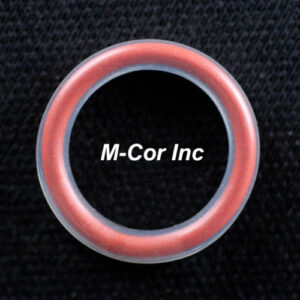M-Cor Encapsulated O-Rings: Quality vs Cost-Cutting
Quality vs Cost-Cutting: M-Cor Inc. is a specialty bespoke manufacturer of high-performance Teflon encapsulated sealing products. Founded in 1987, we have established ourselves as an industry leader in custom-engineered sealing solutions for critical applications across multiple industries including aerospace, pharmaceutical, semiconductor, chemical processing, and oil & gas.
Our Montana facility specializes in precision manufacturing of fluoropolymer encapsulated elastomeric cores, delivering products that combine the chemical resistance of fluoropolymers with the mechanical properties of various elastomers.
Quality Parameters
Without question, the quality of Teflon encapsulated O-rings is paramount as they’re often deployed in critical applications where failure is not an option. Consequently, key quality considerations include:
-
- Dimensional accuracy – Precise tolerances ensure proper compression and sealing integrity
- Surface finish uniformity – A smooth, defect-free surface prevents leak paths
- Jacket integrity – The Teflon encapsulation must be free from voids, tears, or thin spots
- Core resilience – The elastomer core must provide consistent recovery properties
- Thermal stability – Quality rings maintain performance across specified temperature ranges
Cost-Cutting Practices to Avoid
Unfortunately, some manufacturers resort to questionable practices to reduce production costs, which subsequently compromises performance and reliability. Hence, buyers should be vigilant about these common corner-cutting tactics:
Substandard Core Materials
Some producers incorporate low-cost fillers into the elastomer core, thus diluting its resilience and compression-set resistance. As a result, these adulterated cores deteriorate more rapidly under compression and temperature cycling.
Inferior Teflon Quality
Rather than using virgin PTFE, certain manufacturers utilize lower-grade or even recycled polymers for the jacket material. Consequently, these compromised jackets exhibit reduced chemical resistance, higher permeability, and inferior mechanical properties.
Teflon Wall Thickness decreased
To save on raw material costs some manufactures may decrease wall thickness which increase chemical and gas permeation rates, This can cause premature seal failure.
Improper Core Sizing
In many cases, manufacturers improperly size the elastomer core relative to the Teflon jacket, thereby creating air gaps between the elastomer and Teflon layers. Accordingly, these voids lead to premature collapse of the seal under pressure and inconsistent recovery characteristics.
Inconsistent Welding Procedures
The seam where the Teflon jacket is welded closed represents a critical vulnerability. Therefore, rushed or imprecise welding procedures result in weak points that are prone to failure under pressure or chemical attack.
Beyond Quality: Additional Considerations
Although quality serves as the foundation, nevertheless, several other factors warrant attention when selecting and implementing these specialized sealing components:
Application-Specific Requirements
First and foremost, the precise operating conditions dictate optimal material selection. Additionally, the core elastomer (silicone, FKM, or other) and jacket thickness should be tailored to the specific thermal, chemical, and pressure profiles of the application.
Installation Methodology
Even premium-quality O-rings can fail prematurely if improperly installed. Therefore, dedicated installation tools and procedures prevent jacket damage during assembly, particularly when navigating over threads or sharp edges.
Regulatory Compliance
For applications in food processing, pharmaceutical, or medical sectors, materials must meet FDA, USP, or equivalent standards. Subsequently, documentation of compliance should accompany high-quality components.
Total Cost of Ownership
While premium Teflon encapsulated O-rings command higher initial costs compared to standard elastomer seals, nonetheless, their extended service life in harsh environments often delivers superior long-term value through reduced maintenance interventions and system downtime.
Supplier Partnership
Beyond the component itself, moreover, the expertise and support of the manufacturer or distributor can prove invaluable. Furthermore, technical assistance with material selection, design optimization, and troubleshooting capabilities should factor into supplier evaluation.
In conclusion, the narrative surrounding M-Cor Teflon encapsulated O-rings must ultimately extend beyond mere quality metrics to encompass the entire ecosystem of considerations that ensure optimal performance in demanding sealing applications. Above all, recognizing and avoiding substandard manufacturing practices is essential for achieving reliable, long-term sealing solutions.
Solutions for Ensuring Quality Purchases
Supplier Qualification
Thoroughly vet potential suppliers by requesting quality certifications (ISO 9001), manufacturing process documentation, and material certifications. Additionally, consider site visits to observe manufacturing processes firsthand whenever possible.
Material Verification Testing
Implement random batch testing of received products, including:
- Hardness testing of the core elastomer
- FTIR analysis to verify genuine PTFE jacket material
- Cross-section examination to check for air gaps between core and jacket
- Compression set testing to evaluate resilience
Detailed Specifications
Develop comprehensive product specifications including:
- Precise dimensional tolerances
- Material requirements (virgin PTFE, specific elastomer durometer)
- Surface finish requirements
- Weld quality standards
- Performance parameters under temperature and pressure
Sample Evaluation
Request production samples before large orders and subject them to application-specific testing. Furthermore, compare samples from multiple suppliers under identical conditions.
Supply Chain Transparency
Request full disclosure of material sources and manufacturing locations. Moreover, establish traceability requirements for all components in the final product.
Long-Term Performance Metrics
Track mean-time-between-failure data for each supplier’s products in your applications. Consequently, this historical performance data becomes invaluable for future purchasing decisions.
Collaborative Development
Engage with suppliers willing to collaborate on application-specific designs rather than simply providing catalog items. Therefore, these partnerships often yield superior performance and reliability.
Total Cost Analysis
Develop comprehensive TCO (Total Cost of Ownership) models that factor in installation costs, maintenance requirements, downtime impact, and replacement frequency. Subsequently, this approach justifies premium pricing for demonstrably superior products.
In conclusion, implementing these solutions creates a robust framework for consistently sourcing high-quality Teflon encapsulated O-rings that deliver reliable performance in your critical applications.

